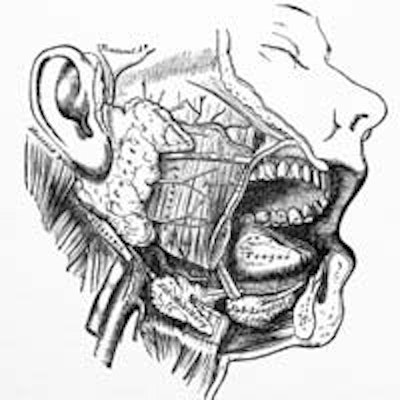
Researchers at the Scripps Research Institute in Florida have made a clinical discovery that could help physicians develop new treatments for an oral cancer that affects the salivary glands, according to a new study in Proceedings of the National Academy of Sciences (July 28, 2014).
The researchers found a link between mucoepidermoid carcinoma and a set of genes known to promote tumor growth.
The study shows that a pair of proteins joined together by a genetic mutation -- known as CRTC1/MAML2 (C1/M2) -- work with myelocytomatosis oncogene (MYC), a protein commonly associated with other cancers, to promote the oral cancer's growth and spread. The authors noted that they did not expect to find this activity of the C1/M2 oncoprotein.
 Michael Conkright, PhD. Image courtesy of the Scripps Research Institute.
Michael Conkright, PhD. Image courtesy of the Scripps Research Institute."Surprisingly, here we report a gain-of-function activity of the C1/M2 oncoprotein that directs its interactions with myelocytomatosis oncogene (MYC) proteins and the activation of MYC transcription targets, including those involved in cell growth and metabolism, survival, and tumorigenesis," wrote lead study author Antonia Amelio, PhD, lead researcher and biologist Michael Conkright, PhD; and colleagues from Scripps.
They noted that their results were tested and confirmed in human mucoepidermoid tumor cells that harbor the t (11, 19)(q21;p13.1) translocation and express the C1/M2 oncoprotein.
These new findings deepen the understanding of C1/M2's role by revealing that it works with a family of cancer-associated genes known as the MYC family to drive the cellular changes necessary for a tumor to develop.
Notably, the authors stated, the C1/M2-MYC interaction is "necessary for C1/M2-driven cell transformation," and the C1/M2 transcriptional signature predicts other human malignancies having this combined involvement of MYC and CREB. They note that their findings "suggest that such gain-of-function properties may also be manifest in other oncoprotein fusions" found in human cancer.
The study findings might offer a new tactic for anticancer therapeutic treatments, the authors wrote.
"Our findings suggest that targeting the C1/M2-MYC interface represents an attractive strategy for the development of effective and safe anticancer therapeutics in tumors harboring the t (11, 19) translocation," they wrote.
“This research provides new insights into the molecular mechanisms of these malignances and points to a new direction for potential therapies.”
Because the role of C1/M2 and its interactions with another protein, CREB, in the development of mucoepidermoid carcinoma are well-understood, physicians screen patients for the presence of the C1/M2 protein when testing for this cancer.
"This research provides new insights into the molecular mechanisms of these malignances and points to a new direction for potential therapies," stated Conkright in a press release.
The C1/M2 protein is created when the genes encoding CRTC1 and MAML2 mutate into a single gene (a process known as chromosomal translocation). These mutant "chimera" genes have been linked to the formation of several forms of cancer. The Scripps researchers found that the C1/M2 protein further activates genetic pathways regulated by MYC, in addition to CREB, to begin a series of cellular changes leading to the development of mucoepidermoid carcinoma.
"The identification of unique interactions between C1/M2 and MYC suggests that drugs capable of disrupting these interactions may have therapeutic potential in the treatment of mucoepidermoid carcinomas," said Amelio, who is now an assistant professor with the University of North Carolina (UNC) School of Dentistry and member of the UNC Lineberger Comprehensive Cancer Center.
The discovery of these new protein interactions may also reveal insights into the mechanisms behind other cancers that arise due to other genetic mutations involving the CREB and MYC pathways.



















